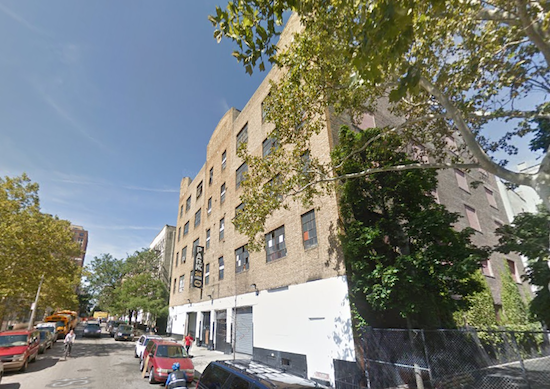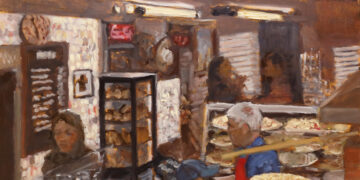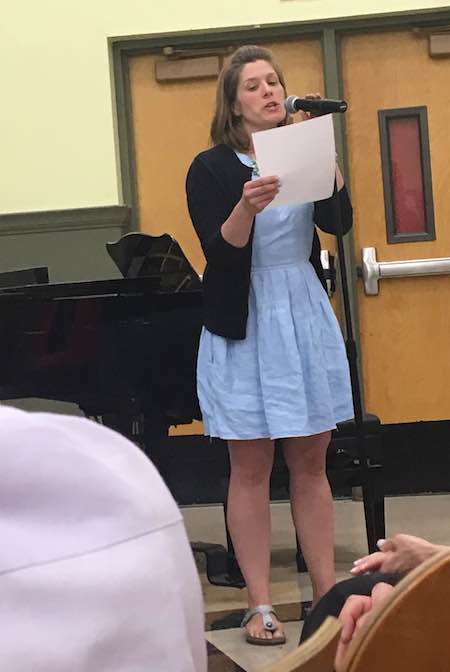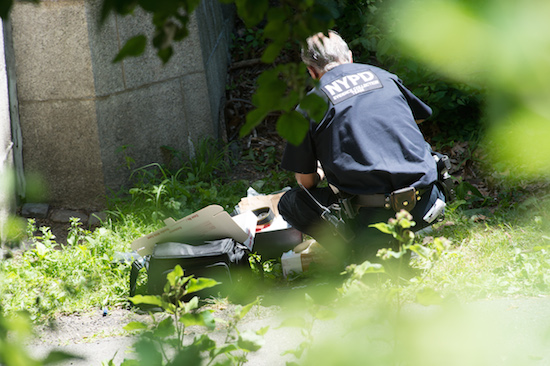A plan to build an expanded affordable housing complex at 149 West 108th street is drawing protests from local residents, who say the neighborhood already has enough affordable housing, and the new building would be too tall.
The affordable housing proposal will be reviewed by a community board committee on Wednesday night at 6:30 pm at Booker T Washington Middle School, 103. W. 107th Street.
We reported on the first meeting about this issue here. The project involves Valley Lodge, a facility at 149 West 108th street with 92 transitional beds for people over 50, which is owned and managed by West Side Federation for Senior and Supportive Housing, and three municipal parking garages owned by HPD.
In the plan, Valley Lodge and the two city garages immediately adjacent would be demolished and rebuilt as one super-structure with a total of 110 transitional beds, 78 affordable housing units, and 115 units of supported living. WSFSSH is looking for a zoning variance to build as high as 11 stories.
Among the largest concerns at that meeting was the destruction of the garages, where parking spots are more affordable than at most neighborhood garages.
People from a new group called Save Manhattan Valley say the parking issue is ancillary to larger concerns. They are planning to protest and speak out at the meeting. They say the proposed 11-story building is too tall in a neighborhood zoned for structures that are seven stories or less. And they say in a release sent out by a public relations firm that there’s already too much affordable housing and shelters in that area.
“Manhattan Valley is already home to close to 50% of the affordable housing on the Upper West Side. This is more than its fair share requirement of affordable housing–and this statistic does not include temporary shelters and dozens of residential social-service support programs in the neighborhood.”
The full explanation of the group’s concerns is below:
KEY CONCERNS:
►ZONING: The proposal by WSFSSH for an 11-story building violates the R8B protective zoning law, which limits all new construction to seven stories on small side streets north of W 96th St. That law, which Manhattan Valley’s then City Council member Melissa Mark-Viverito fully endorsed, has not been violated since it passed City Council in 2007. If the zoning variance is granted, it sets a dangerous precedent for all future construction in our community.
►FAIR SHARE: Manhattan Valley is already home to close to 50% of the affordable housing on the Upper West Side. This is more than its fair share requirement of affordable housing–and this statistic does not include temporary shelters and dozens of residential social-service support programs in the neighborhood.
►ENVIRONMENT: Booker T Washington and large playing fields are directly across the street from the proposed construction, exposing the children and staff to all manner of hazardous toxins. Bill 420, which provides protection from all such hazards (and may advance from a distance of 75 feet to 200 feet) is in the works, but not yet passed. Before the City Planning Department certifies the project, a full environmental review should be made available to the Manhattan Valley community, including the schools’ parents and educators, for study and review.
►LOSS OF GARAGES: The three 108th Street garages provide affordable parking for 800 cars belonging to residents, neighborhood merchants, the Central Park Medical Unit ambulances (space free of charge), St. Luke’s Hospital workers, Columbia University staff and visitors, and others. They have been serving Manhattan Valley’s lower-income and middle-class families, and surrounding businesses for 30+ years. With little street parking available, and highly prohibitive costs at the few privately owned garages, the loss of 800 parking spaces will be devastating to these populations as well as to all those currently parking their cars on the streets. Competition for parking is already increased due to bike lanes and CitiBike ports. Hundreds of additional cars circling streets in search of parking will increase noise, traffic, double-parking, and will harm the quality of life of Manhattan Valley residents.
►ETHICS: WSFSSH, which has over 20 facilities in two boroughs, has never demolished an essential community resource to construct a new facility. Save Manhattan Valley finds it unacceptable that WSFSSH for the first time is endorsing removal of such a resource, without community approval, thereby establishing another dangerous precedent.
“Not only have the City of New York & the West Side Federation for Senior & Supportive Housing failed to collaborate with the Manhattan Valley community about this project: they have come up with a plan that pits deserving constituencies against each other. The City & WSFSSH must cooperate with our community to create a plan that leaves no one out in the cold,” says Glory Ann Kerstein.










“the proposed 11-story building is too tall in a neighborhood zoned for structures that are seven stories or less.”
True
Zoning is for a reason. Not the base to exceed.
Zoning variances are granted all the time. Especially when the project helps with public amenities (e.g. parks, schools, public housing).
This is a good project that will help out the community and the additional height is well worth it to ensure a viable project
11 stories is not that bad. Look at Lincoln square, they have a 50 story building going up in a very congested area.
Thank you, Save Manhattan Valley, for being the strong voice of our neighborhood!
Good God! How can you have too much affordable housing?
Protesting against affordable housing. Wow, things have changed on the UWS.
“affordable housing” seems to be a very fluid term with this administration. Will it be affordable housing in Staten Island that the developer has to build in order to put expensive condos up in Manhattan? We are in a bad position having to argue against what they label ‘affordable housing.’ They could call it, ‘save the babies & puppies housing.’ We become the bad guys. This is by design. New zoning is being voted on in Albany that would allow the zoning to change here in NYC. As soon as that goes through, 11 stories will be the least of our concerns. https://www.landmarkwest.org/damaging-state-bill-threatens-our-neighborhoods/
The headline is misleading (and slanted). Those protesting aren’t against affordable housing per se, but are concerned about the many real problems, enumerated above, this plan for the neighborhood would cause. Environment, impact on school children, affordable parking, and legal precedent are real concerns. This is not an either-or; this is a bad plan.
So it’s a NIMBY-argument. These are concerns that would apply in any neighborhood in NYC. You just don’t want it in yours.
Won’t someone think of the cars?!
The zoning is the only compelling point made. I don’t like overly-restrictive zoning, but it’s the law and so the onus is on the builders to present a compelling reason for a variance.
They lost me on the bit about the unspecified “toxins”. (All manner of them!!!1one)
There is already a ton of projects in Manhattan Valley. Why not go up to Harlem or Washington Heights?
They only care about the parking. Homeless people on the street, who cares?
Over the decades an array of social organizations have been placing various ‘affordable’ and supportive housing within a small compressed area above Park West Village…..that ‘wall’ at West 100 Street has created 2 worlds within the Upper West Side. The Manhattan Valley community is a Federally-designated impoverished area and the entire Upper West Side knows the reasons for this. Over the years social organizations know that the Manhattan Valley community is the only ‘soft’ spot within the Upper West, thus a policy has evolved over the years to direct the majority of ‘affordable’ projects in Manhattan Valley… 40% of such projects are housed in Manhattan Valley. The southern border…..the area south of Park West Village has a much higher population density yet within a broader space they are host to far less ‘affordable’ housing sites within the Upper West Side. Supportive social groups are under the radar and they are not part of the statistics, however it is clear that a larger proporation are placed in Manhattan Valley.
The issue is not simply about ‘affordable’ housing vs. parking….there is a broader spectrum of issues and they need to be addressed and the entire Upper West Side community needs to be sensitive to these issues. The Manhattan Valley community is a graphic example of a segregated community that has been evolving over the decades and this has been set in motion by social groups, the Community Board, and local politicians. Social groups as West Side Federation for Senior and Supportive Housing are a machine that manipulates the system in order to promote and fulfill their mission. However, using their mission statement in order to provide housing they have used strategies that are outrageous and this includes silencing the voices and opinions of individuals that care and love Manhattan Valley……these are the residents that live and work in this community. For some reason WSFSSH believes that Manhattan Valley is a vacuum and that they have a sense of entitlement to ‘plow’ through the community without any regard for any impact that it might have. They have demonstrated a lack of community concern for this immediate area as evident by their numerous projects within a 5-block radius.
Why do people such as the Board of West Side Federation for Senior and Supportive Housing think they know what is best for a community that has been denied and neglected of basic services? This view has been reflected by some of the members of Community Board 7 over the years…..they know what is best……for the residents that live here.
The very people that know what is best for us live beyond the frontier of Manhattan Valley….they south or within an oasis called Park West Village. They live on West End Avenue or west of. This project is part of a continium that has been evolving over the years. The residents live in deplorable conditions and it has become part of our daily lives so much that we have been lead to believe that we are not empowered and we can do nothing to improve lives for ourselves and families. We are host to active and dangerous gangs, violent crime is part of the fabric of this community and yet we have always embraced social groups, but there is a limit and we do have a voice.
Manhattan Valley, a community with the an entrenched stigma: it is a worrying reminder to the Upper West Side of what is just north of them……’that’ community that lies north of Park West Village…..a community called Manhattan Valley.
I live in an 17 story that is basically across the street from this site. Strongly support this development. In the 25 years I have lived in this neighborhood we have seen massive displacement as a result of gentrification. This parcel is unique in the area and affordable housing for seniors and families is the best use. The garages, which are across the street from a middle school, are graffiti covered eyesores. Your NYC tax dollars are underwriting the subsidized parking there because the buildings are owned by the city and leased at below market rates to the garage operators. No zoning issues, no concentration issues, this is all about parking – the other arguments are specious.
Sorry Julie, I completely disagree. This is not an issue about parking. This being labelled “affordable housing” is misleading. It is a development for those with no income. A family of 4 making more than $30,000 would be inelliglbe to live here. It will not benefit those who grew up in the community. It will not benefit hard working people who can’t pay market rents. It is simply housing for those who have essentially zero income. Manhattan Valley has plenty of developments directed towards that purpose. If they want to create that sort of development, that’s fine, just put it in an area that is not already over-saturated with it.
Many are not opposed to developing that area. Many are opposed to THIS plan because it is not a proper use of the space. How about a mixed development plan that includes “affordable housing” for people that actually are gainfully employed and have a real income, but simply can’t afford high rents? Put together a proposal that fits within the zoning and includes that and I’m sure you’ll find many more people willing to accept it.
is there a link to the income requirements/
$30K per year is not “essentially zero” income. maybe if you ared upper middle class or rich… but a huge percentage of New Yorkers live on less than 30k per year.
many full time NYC jobs pay about 30K.
if you make $15/hr and work 40 hours per weerk every week, with no unpaid vacation, your gross will be $31,200.
Julie made perfect sense to me. but i also am appalled at the arrogance of someone who would call 30K a year “essentially zero” income. how unaware can one be?
Ah the graffiti rant… How basic. Graffiti will disappear when moss stops growing on trees in the forest. Welcome to the big city.
I don’t really care about the car vs. housing argument. I think many are missing an important consideration. How are the children in the middle school across the street going to be able to learn and be kept safe from the lead paint and aspestos that is surely in the buildings that are being to be demolished? How will they be able to concentrate when there are pile drivers banging icessantly? what about their recess yard? how will that be kept free of dust a d debris? Aren’t over 1000 children who will be directly effected daily, for years entitle to a safe environment conducive to learning?
Are you joking? How do you think anything gets built in NYC?
They will test if any hazardous materials are present and if any are present, professional mitigation crews come in and remove it. Just like hundreds of buildings across the city every year.
I don’t know to what extent outdoor construction noise affects children studying inside of a school but asbestos is contained when buildings are dismantled. There’s a private school on the UES where there has been ongoing construction for over 2 years and I’ve never heard any complaints about it. Isn’t that just part of life here?
About 1/3 of the classerooms face the construction and many have inadequate air conditioners so the windows are open a good part of the year. If you feel that they will not be affected by the noise you are not being realistic. In addition, the schools recess yard is directly across the street (maybe 30 feet) from the bulk of the construction.
A simple solution seems to be to get working air conditioners and seal the windows. I really don’t understand how this is a problem.
Air conditioners are pricy. You can’t just pick one up at Lowe’s and install it. There is DOE red tape and approved vendors to sell and install. The DOE won’t pay for this the PTA has to fund it. It isn’t impossible but isn’t nearly as simple as you simply. It it were all classrooms would already have air conditioning.
For far too long the Upper West Side has been at the mercy of bad city policies. Our neighborhoods should not have to be a repository for every shelter or transitional bed that someone else deems fit to put here. The result is a declining quality of life for us while other neighborhoods improve. Save Manhattan Valley’s efforts to protect their own neighborhood should be supported, not derided.
There are shelters on 100th and b’way, 104th and b’way,109th between riverside and b’way and 108th between Amsterdam and Columbus. So that is 4 of the 6 shelters in CB7. In addition to 2 drug treatment centers on 108th street. How much more should one neighborhood endure? Also This part of Manhattan valley is only 2 blocks from both CB9 and 10 with a combined 26 shelters.
Carol,
If you are going to make the claim that our community is “overburdened” by resources for those less fortunate then you better back it up with facts.
What is your evidence that we have been “burdened” more than any other community in the city?
Otherwise, we should all assume this is just another NIMBY excuse to do nothing.
This is the constant never ending argument.
Why is it that people cannot have sympathy and human compassion for the homeless and those with special needs, but also disagree with the density of such facilities in the 90’s and low 100’s? We get told we just don’t want to look at homeless people. That is a crap. The reality is that there is plenty of facts that clearly indicate there is a higher density of public assistance facilities in that portion of the upper west side. It is not really a perception, it is a fact. The burden of that is also factual, not a perception. There is less local income to support stores and businesses. Do the math: higher portion of low income populations equals less income to support local business resulting in more empty store fronts or more targeted businesses like 7-11’s and dunkin donuts. Ever ask yourself why the store front directly outside the 96th street subway entrance between 93 and 94 is empty? Look around at the garbage on the street on amsterdam.
Keith,
If it’s a fact that the neighborhood is ‘overburdened’, then provide it. That’s all I’m asking for.
So far, no one has backed up this claim after plenty of opportunity. I’m guessing because the facts are contrary to the perception or the whole issue was made up to begin with to cover over for normal NIMBY excuses.
much of this is permanent affordable housing, not “transitional beds” nor “a shelter.”
I guess you just don’t want low income people living anywhere near you. move them further and further away… maybe you’ll never have to look at them.
It may seem like there are a lot of shelters and transitional housing here, but I don’t think it’s true. Only perception.
This article shows that we don’t even have the highest number of shelters in Manhattan.
https://www.dnainfo.com/new-york/20150824/belmont/map-10-community-districts-carry-bulk-of-citys-homeless-shelters
This is my problem with these organizations, they don’t use facts to back up their talking points. Perhaps that’s because the facts don’t back them up.
Jay, you need to dig into the information in that article to see if they are referring to DHS-only shelters or other supportive housing, such as beds and treatment facilities for drug addicts, mentally ill, halfway houses, etc. I can’t speak for Manhattan Valley in particular, but I believe the WSR printed a list of West 90s/100s supportive housing facilities a few years ago, perhaps they can reprint it. More stats can be found at http://www.N90s.org. And recently one member of CB7 told me that roughly 25% of all the supportive housing is within a 10-minute walk from the 96th Street subway. So I don’t think that DNA article tells the whole story.
How about if you find yourself unable to afford living in the city you move?
I know there are probably extenuating circumstances, but people who decide to have families get priced out of the city all the time – they move to the suburbs. I’m not saying the entire city should be glass skyscrapers, but why are we building more and more affordable housing? This is obviously a signal that having affordable housing is not help those who are living there.
Maybe I’m missing a larger point. I’m all ears and want to be educated. So, if I’m missing something, please inform me.
People receive lower incomes and need housing.
Agreed. But perhaps not all in the same neighborhood.
Affordable housing exists in all 5 boroughs, you just feel like it is all in your neighborhood.
I was at the meeting last night, and the main concern seems to be parking. There are very few monthly spaces in the other garages in the neighborhood, at any price. And that will only drive up the very high prices in those other garages. The car count in these 3 garages that was given at the meeting was high 800’s (889, I think) and there are only a total of 150 vacancies (approx.) in 23 other garages in the area. Some people need their cars to get to work–teachers and musicians, for instance. There will be a negative community impact here that is really not fair. I am not against the housing project, but some adjustment needs to be made.
Sorry, a correction–official count is 667 spaces in present garages.